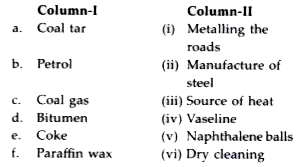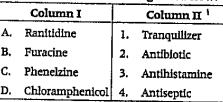Match column I with column II and select the correct option form the codes given below.
Column IColumn IIA. Delivers blood to glomerulus(i). Ascending and descending limbsB. Carries urine to pelvis(ii). Renal arteryC. Collects filtrate from Bowman's capsule(iii). Collecting ductD. Loop of Henle(iv). PCT
A-(ii),B-(iii),C-(iv),D-(i)
A-(i),B-(iii),C-(ii),D-(iv)
A-(ii),B-(iv),C-(i),D-(iii)
A-(iv),B-(iii),C-(ii),D-(i)
The correct Answer is:A
Topper's Solved these Questions
- EXCRETORY PRODUCTS AND THEIR ELIMINATIONBOOK - NCERT FINGERTPS ENGLISHCHAPTER - EXCRETORY PRODUCTS AND THEIR ELIMINATIONEXERCISE - Assertion & Reason
15 Videos
- EXCRETORY PRODUCTS AND THEIR ELIMINATIONBOOK - NCERT FINGERTPS ENGLISHCHAPTER - EXCRETORY PRODUCTS AND THEIR ELIMINATIONEXERCISE - Excretory Products And Their Elimination
133 Videos
- DIGESTION AND ABSORPTIONBOOK - NCERT FINGERTPS ENGLISHCHAPTER - DIGESTION AND ABSORPTIONEXERCISE - Digestion And Absorption
137 Videos
- LOCOMOTION AND MOVEMENTBOOK - NCERT FINGERTPS ENGLISHCHAPTER - LOCOMOTION AND MOVEMENTEXERCISE - Locomotion And Movement
139 Videos
Similar Questions
Match column I with column II and select the correct option from the codes give below.
Column IColumn IISpirogyra(i). UnicellularB. Chlamydomonas(ii). FilamentousC. Volvox(iii). Colonial formD. Some giant marine forms(iv) Kelps
View SolutionMatch column I with column II and select the correct option from the codes given below
Column IColumn IIA. Psilopsida(i). PsilotumB. Lycopsida(ii). EquisetumC. Sphenopsida(iii). SelaginellaD. Pteropsida(iv). Dryopteris
View Solution
Knowledge Check
Match the Column-I with Column-II and select the correct option given below.
 Aa-(v), b-(vi), c-(iii), d-(i), e-(ii), f-(iv)Ba-(i), b-(iv), c-(iii), d-(ii), e-(v), f-(vi)Ca-(iii), b-(v), c-(i), d-(iv), e-(ii), f-(vi)Da-(iv), b-(i), c-(vi), d-(iii), e-(v), f-(ii)
Aa-(v), b-(vi), c-(iii), d-(i), e-(ii), f-(iv)Ba-(i), b-(iv), c-(iii), d-(ii), e-(v), f-(vi)Ca-(iii), b-(v), c-(i), d-(iv), e-(ii), f-(vi)Da-(iv), b-(i), c-(vi), d-(iii), e-(v), f-(ii)Match column I with column II and select the correct option from the codes given below.
Column IColumn IIA. Cleavage(i). FertilisationB. Morula(ii). Mitotic divisionsC. Polyspermy(iii). EndometrialD. Implantation(iv). Little mulberryAA-(ii),B-(iv),C-(i),D-(iii)BA-(i),B-(iv),C-(ii),D-(iii)CA-(iv),B-(ii),C-(i),D-(iii)DA-(ii),B-(iv),C-(iii),D-(i)Match column I with column II and select the correct option from the codes given below.
Column IColumn IIA. Cleavage(i). FertilisationB. Morula(ii). Mitotic divisionsC. Polyspermy(iii). EndometrialD. Implantation(iv). Little mulberryAA-(ii),B-(iv),C-(i),D-(iii)BA-(i),B-(iv),C-(ii),D-(iii)CA-(iv),B-(ii),C-(i),D-(iii)DA-(ii),B-(iv),C-(iii),D-(i)
Match column I with column II and select the correct option from the codes given below
Column IColumn IIA. Psilopsida(i). PsilotumB. Lycopsida(ii). EquisetumC. Sphenopsida(iii). SelaginellaD. Pteropsida(iv). Dryopteris
View SolutionMatch column I with column II and select the correct option from the codes give below.
Column IColumn IIA.Spirogyra(i).UnicellularB.Chlamydomonas(ii).FilamentousC.Volvox(iii).Colonial formD.Some giant marine forms(iv) Kelps
View SolutionMatch column I with Column II and select the correct option from the codes given below
Column IColumn IIA. Pteris(i). BryophyteB. Cedrus(ii). PteridophyteC. Sonchus(iii). GymnospermsD. Marchantia(iv). Angiosperm
View SolutionMatch the medicines given in column I with their use given in column II and select the correct option from the codes given below

View SolutionMatch column I with column II and select the correct option from the codes given below.
Column IColumn IIA.Acrosome(i)Rudimentary erectile tissueB.Endometrium(ii)UterusC.Polar body(iii)OogenesisD.Clitoris(iv)Spermatozoon
View Solution
